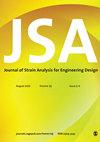利用动态压痕试验和人工神经网络确定材料模型参数
IF 1.8
4区 工程技术
Q3 ENGINEERING, MECHANICAL
Journal of Strain Analysis for Engineering Design
Pub Date : 2022-12-23
DOI:10.1177/03093247221140981
引用次数: 0
摘要
材料的应力-应变曲线通常随应变速率和温度变化,通常由材料模型定义。本研究提出了一种确定材料模型常数的新方法。该技术是基于动态压痕试验、Ls-dyna代码和人工神经网络的数值模拟。用气枪将锥形压头作为靶射向材料。实验在四种应变速率和四种温度下进行。靶子是纯铜做的。利用LVDT和压电式测力元件分别捕获了穿透深度-时间和载荷-时间历程,得到了载荷-穿透深度曲线(P-h)。该曲线由五个参数表征,这些参数是为每个压痕测试确定的。另一方面,用Ls-dyna hydrocode模拟了压痕试验。通过模拟得到了Johnson-Cook (J-C)和zerillii - armstrong (Z-A)材料模型的P-h曲线,并确定了数值P-h曲线的表征参数。最后,以数值P-h曲线参数作为输入,J-C和Z-A模型常数作为输出,训练人工神经网络(ANN)。然后以实验p-h曲线参数作为输入,J-C和Z-A模型的常数作为输出,对训练好的神经网络进行测试。此外,在与压痕试验相同的应变速率和温度下,使用著名的Split Hopkinson棒进行了多次动态压缩试验,得到了材料的应力-应变曲线。神经网络预测的应力-应变曲线与Split Hopkinson杆模型吻合较好。该方法不需要复杂的仪器,实际上,通过人工神经网络将载荷时间和压痕深度时间历史直接转换为材料的应力-应变。本文章由计算机程序翻译,如有差异,请以英文原文为准。
Determination of the parameters of material models using dynamic indentation test and artificial neural network
Stress-strain curves of materials normally change with strain rate and temperature and are normally defined by material models. In this study, a new technique was developed for determining the constants of material models. This technique was based on dynamic indentation test, numerical simulation using Ls-dyna code and artificial neural network. An indenter of tapered shape was shot against the materials as the target by a gas gun. The experiments were carried out for four strain rates and four temperatures. The target was made of pure copper. The penetration depth-time and load-time histories were captured by a LVDT and a piezoelectric load-cell, respectively and the load-penetration depth curve (P-h) was obtained. This curve is characterized by five parameters which are determined for each indentation test. On the other hand, the indentation test was simulated using Ls-dyna hydrocode. From the simulations, the P-h curves were obtained using Johnson-Cook (J-C) and Zerilli-Armstrong (Z-A) material models and the characterizing parameters of the numerical P-h curves were also identified. Finally, an artificial neural network (ANN) was trained by the numerical P-h curves parameters as the input and the constants of J-C and Z-A models as the output. The trained neural network was then tested by the experimental p-h curves parameters as the input and the constants of J-C and Z-A models as the output. Moreover, a number of dynamic compression tests were performed using the well-known Split Hopkinson Bar at the same strain rates and temperatures used for indentation tests and the stress-strain curves of material were obtained. A reasonable agreement was observed between the stress-strain curves predicted by neural network and the Split Hopkinson Bar. The proposed method does not need sophisticated instrumentation and in fact, the load-time and indentation depth-time histories are directly converted to stress-strain of material using an artificial neural network.
求助全文
通过发布文献求助,成功后即可免费获取论文全文。
去求助
来源期刊

Journal of Strain Analysis for Engineering Design
工程技术-材料科学:表征与测试
CiteScore
3.50
自引率
6.20%
发文量
25
审稿时长
>12 weeks
期刊介绍:
The Journal of Strain Analysis for Engineering Design provides a forum for work relating to the measurement and analysis of strain that is appropriate to engineering design and practice.
"Since launching in 1965, The Journal of Strain Analysis has been a collegiate effort, dedicated to providing exemplary service to our authors. We welcome contributions related to analytical, experimental, and numerical techniques for the analysis and/or measurement of stress and/or strain, or studies of relevant material properties and failure modes. Our international Editorial Board contains experts in all of these fields and is keen to encourage papers on novel techniques and innovative applications." Professor Eann Patterson - University of Liverpool, UK
This journal is a member of the Committee on Publication Ethics (COPE).
 求助内容:
求助内容: 应助结果提醒方式:
应助结果提醒方式:


